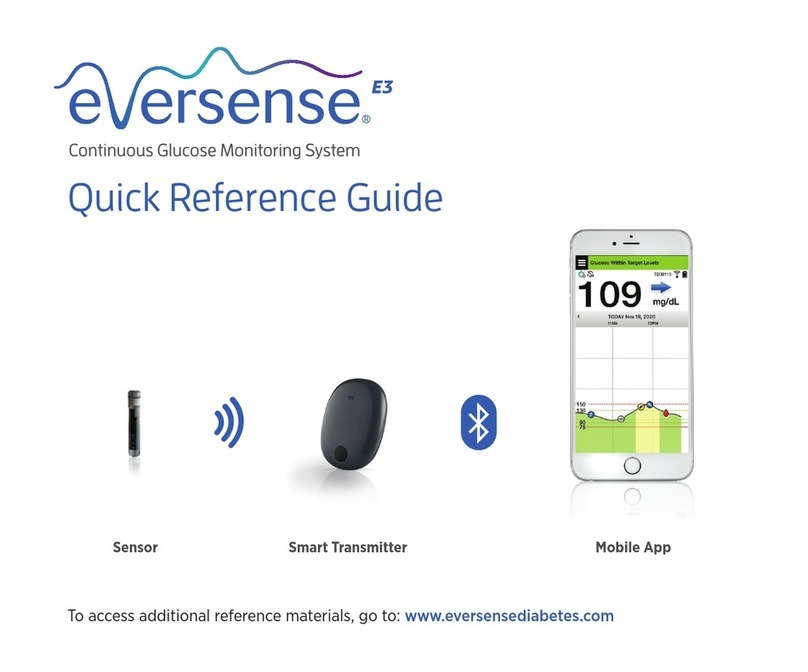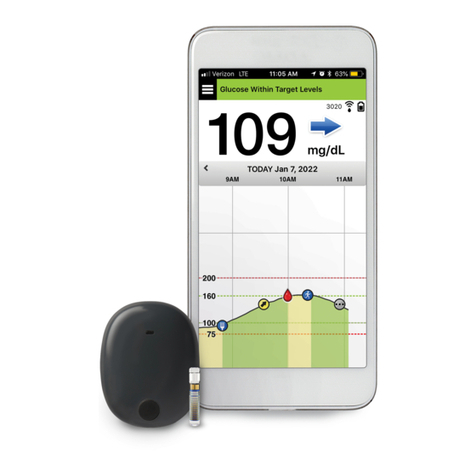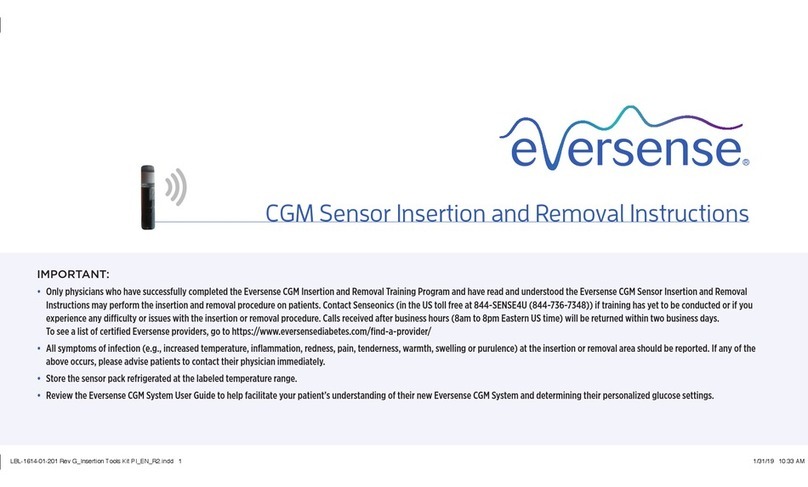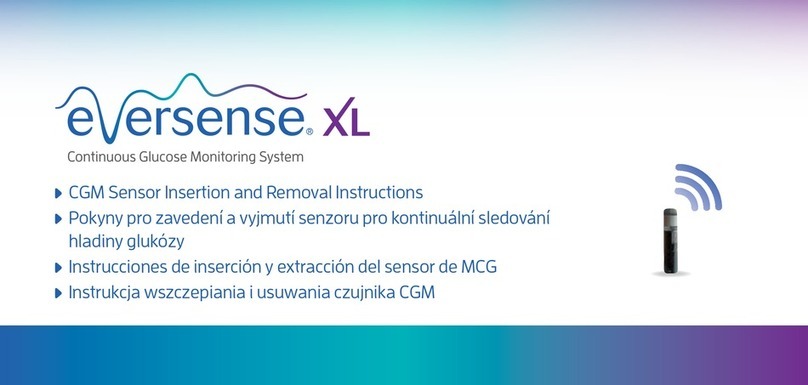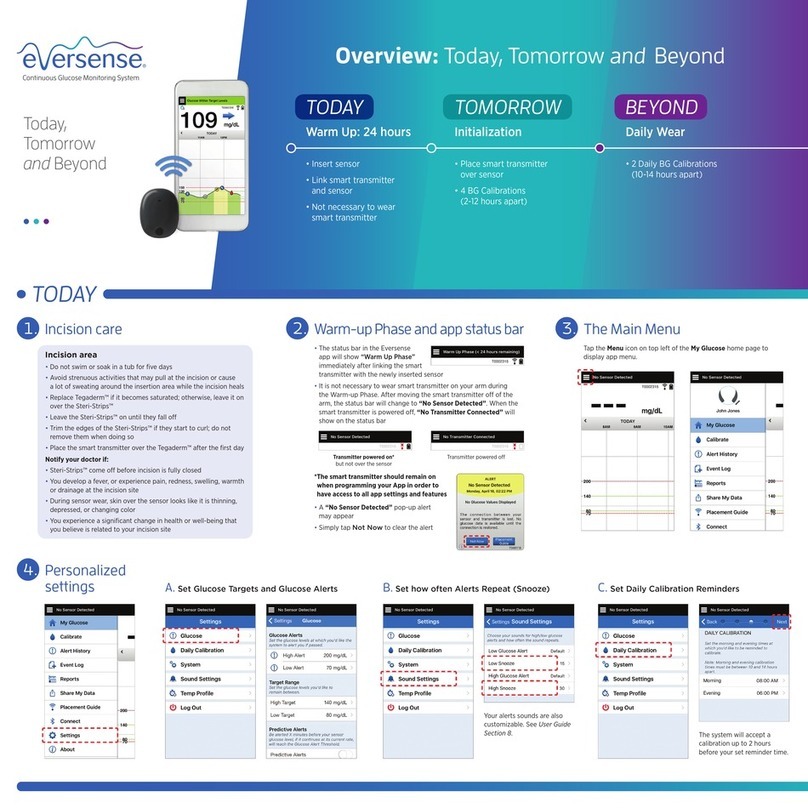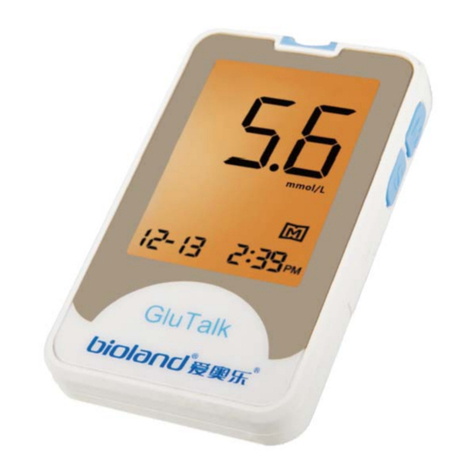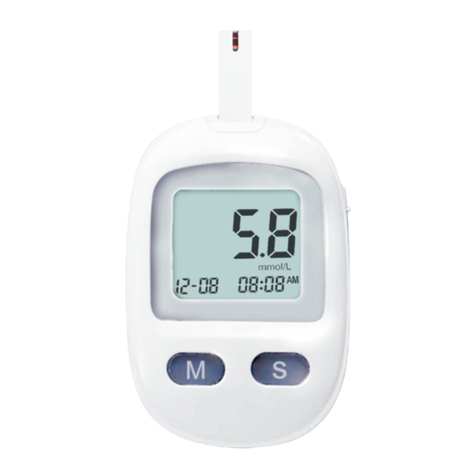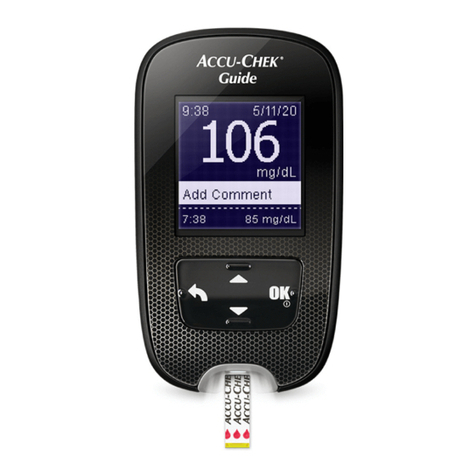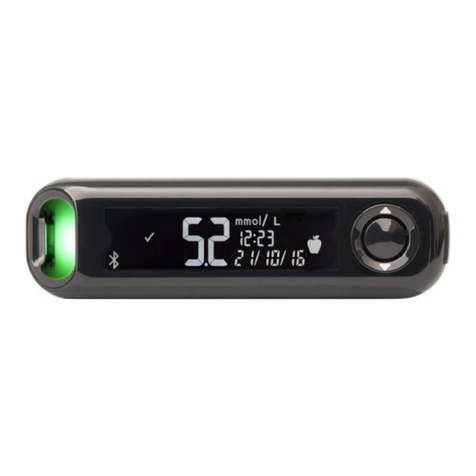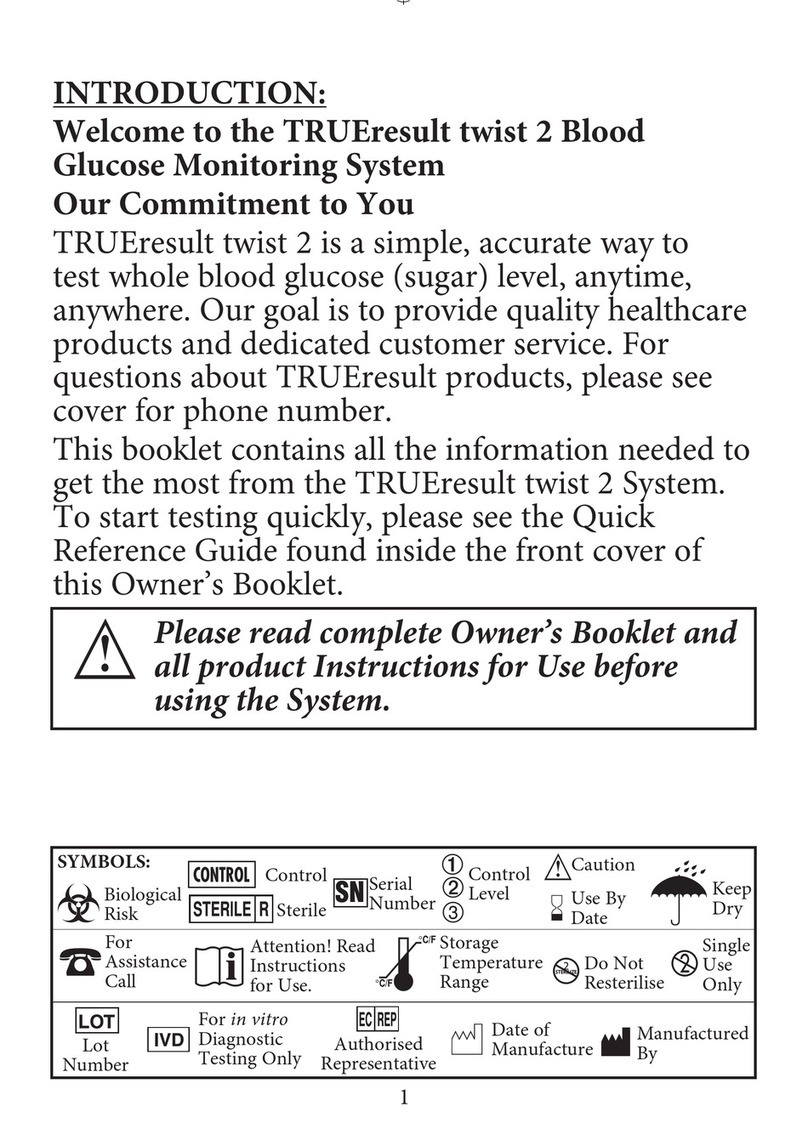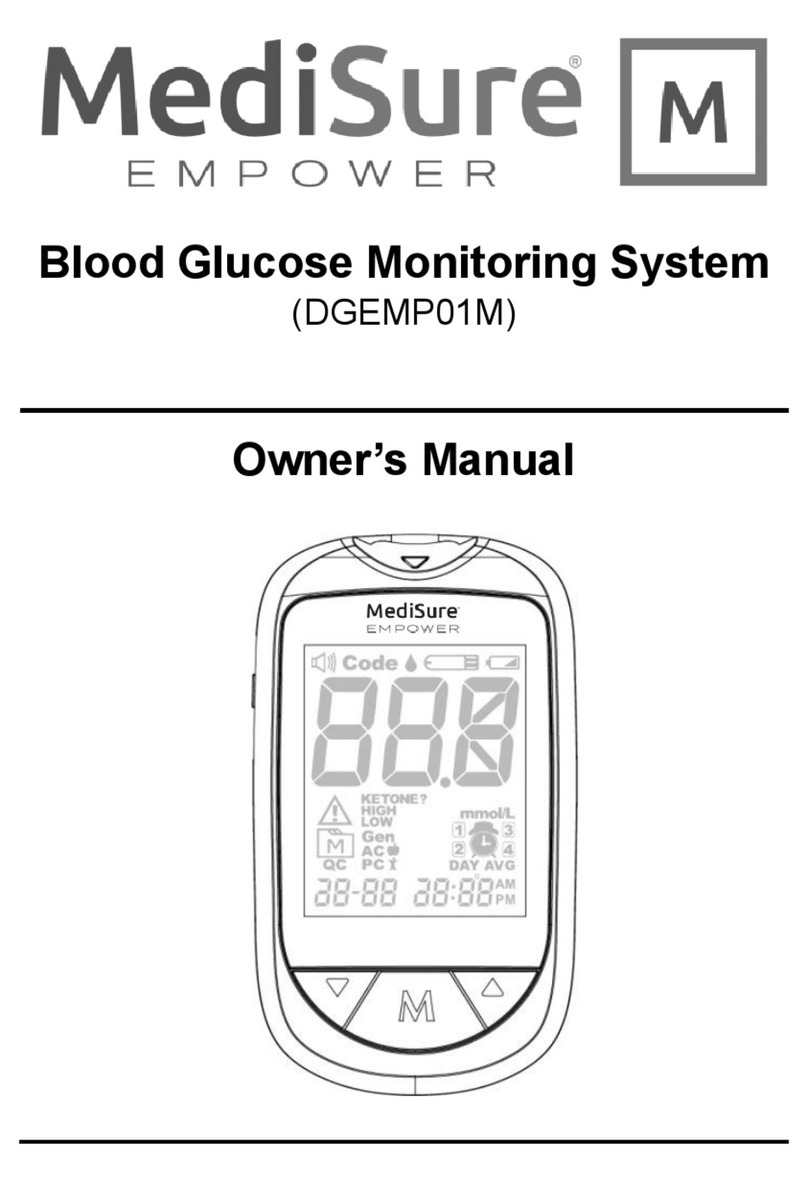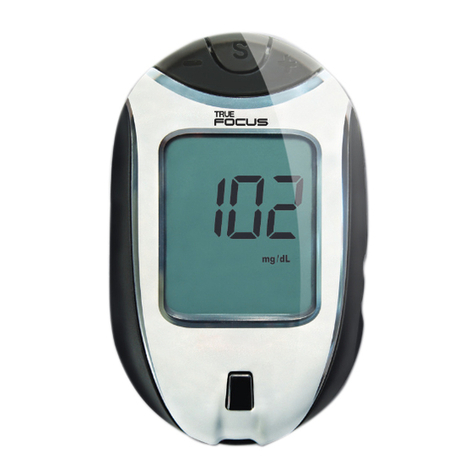eversense XL User manual

Smart TransmitterSensor
User Guide
A guide for using the Eversense XL
Continuous Glucose Monitoring System
Mobile App


Eversense XL Trademark
Eversense XL, Eversense XL Continuous Glucose Monitoring, Eversense XL CGM, Eversense XL Sensor, Eversense XL
Smart Transmitter, Eversense App and the Eversense XL logo are trademarks of Senseonics, Incorporated. Other
brands and their products are trademarks or registered trademarks of their respective holders.

Contents
Glossary 5
1. Introduction 7
Help and Support 7
Eversense XL CGM System Components 8
System Requirements 12
End User License Agreement
and Privacy Policy 12
Jailbroken Devices 12
Broken Screen or Button 12
Indications for Use 13
Contraindications 13
What is Included in this Package 14
How to Use this User Guide 14
2. Benets and Risks 15
Warnings 16
Risks and Side Eects 16
Cautions 18
3. Getting Started 20
Charge your Smart Transmitter 21
Step 1. Download and Install the App 23
Step 2. Set up the App – Account
Creation, Pairing and Settings 24
4. Inserting and Linking
the Sensor 30
5. Using the
Smart Transmitter 33
Daily Use 34
Secure the Smart Transmitter
over Inserted Sensor 35
Turn the Smart Transmitter
ON and OFF 38
Smart Transmitter Care
and Maintenance 39
Battery Indicator 39
LED Status Indicators 40
6. Calibrating the System 41
Calibration Phases 43
How To Calibrate 45
7. Using the App 50
Check Your Mobile Device Settings 50
Get To Know the “My Glucose” Screen 51
Trend Arrows 54
Trend Graph 55
Menu Options 56

8. Customising your Settings 58
Setting Glucose Target Levels 60
Setting Glucose Alert Levels 62
Setting Predictive Alerts 64
Setting Rate of Change Alerts 66
Setting Daily Calibration Times 68
Setting System Information 70
Setting Mealtimes Schedule 71
Setting Sounds 72
Setting Temporary Profile 74
Logging out 77
9. Alert Descriptions 78
Alerts and Notifications 78
Alert History 79
Alert Descriptions and Actions 80
10. Event Log 96
Glucose 97
Meals 98
Insulin 99
Health 100
Exercise 101
11. Reports 102
Weekly Modal Summary 103
Glucose Pie Chart 104
Glucose Statistics 104
12. Share My Data 105
Eversense Data Management
Software (DMS) Program 105
Sync 106
My Reports 107
13. Product and General
Information on the App 108
14. Viewing Eversense XL Data
on the Apple Watch 110
Glance View 111
15. About the Sensor 113
Insertion Steps 114
Removal Steps 115
16. Travel 116

17. Troubleshooting 117
Smart Transmitter 117
Smart Transmitter Battery and Charging
119
Connection with Smart Transmitter 120
Calibration 124
Alerts and Notifications 126
Glucose Readings 127
Trend Arrows 128
App 129
Sensor 130
Events 132
Sync 132
Shortcuts 132
18. Device Performance 133
Clinical Study Performance -
PRECISE STUDY 133
Overall System Performance
Compared to YSI 134
Clarke Error Grid Analysis 135
Consensus (Parkes) Error
Grid Analysis 139
Calibration Performance 141
Smart Transmitter Wear 142
Safety 142
Sensor Lifetime Analysis 142
19. Technical Specications 143
Sensor 143
Smart Transmitter 144
Power Supply and Charger 145
USB Cable* for Charging and
Downloading 145
Electrical and Safety Standards 146
Symbols on the Eversense Mobile App 149
Symbols on Packaging and Devices 151
Eversense Smart Transmitter
Limited Warranty (Terms) 153
Legal Notices 156
Apple Legal Notice 156
Google Legal Notice 156
About Bluetooth® 156
Bluetooth® Trademark 156
FCC Information 157
Index 158

5
Eversense XL CGM User Guide
Glossary
Alert An alert warns you that a situation needs
your attention and that you should respond/take
appropriate action.
Blood Glucose Meter A commercially available
device used to measure glucose using a blood sample
from a fingerstick.
Bluetooth® A brand name for a wireless networking
technology that uses short wave radio frequencies
(RF) to connect mobile devices and other wireless
electronic devices.
Calibration Blood glucose reading from a fingerstick
sample entered in the Eversense App to check the
accuracy of the system. With the Eversense XL
System, there are two phases: Initialisation Phase
during which 4 fingerstick tests are required, and the
Daily Calibration Phase, during which 1 fingerstick test
is required twice daily.
CGM Continuous Glucose Monitoring. Continuously
monitoring your glucose levels from interstitial fluid
every few minutes.
Contraindication A condition or circumstance in
which a person should not use the device.
CT Computed Tomography
Do Not Disturb Mode (DND in the Eversense App)
When enabled, the smart transmitter will stop providing
vibratory notifications for non-critical alerts. The Do Not
Disturb feature in the Eversense App only controls the
smart transmitter and will not mute or hide smartphone
notifications. Many mobile devices have a separate
Do Not Disturb Mode. Consult the manufacturer’s
instructions for more information.
Electromagnetic Interference (EMI) A strong field of
energy generated by electrical or magnetic devices.
EULA End User License Agreement
Eversense App Software program that is installed on a
mobile device and is used to display CGM glucose data
sent from the smart transmitter.
Eversense DMS A web-based application compatible
with the Eversense App where your glucose data is
stored and can be viewed.
FAQ Frequently Asked Questions
“HI” Reading Indicates a sensor glucose reading is
> 22.2 mmol/L.
Hyperglycaemia An episode of high blood glucose.
Hypoglycaemia An episode of low blood glucose.

6Eversense XL CGM User Guide
Interstitial Fluid (ISF) The fluid between cells in the
body. The Eversense XL CGM measures glucose from
an interstitial fluid sample, versus glucose in a blood
sample obtained from a fingerstick.
Jailbroken Device A device (iPhone or iPod) that has
been modified to remove the controls and limits set by
the original manufacturer.
LED Light Emitting Diode
Linked Sensor A sensor that is connected to a smart
transmitter.
“LO” Reading Indicates sensor glucose reading is
< 2.2 mmol/L.
Mobile Device A handheld device built on a mobile
operating system that runs the Eversense App and
communicates with the smart transmitter.
mg/dL Milligrams per deciliter, a unit of measure that
shows the concentration of a substance in a specific
amount of fluid. In some countries, including the United
States, glucose test results are reported as mg/dL,
indicating how much glucose is in the blood when using
a blood glucose meter, or how much glucose is in the
interstitial fluid when using some CGM systems, like the
Eversense XL CGM System.
mmol/L Millimoles per liter, a unit of measure that
shows the concentration of a substance in a specific
amount of fluid. In many countries, glucose test results
are reported as mmol/L, indicating how much glucose is
in the blood when using a blood glucose meter, or how
much glucose is in the interstitial fluid when using some
CGM systems, like the Eversense XL CGM System.
MRI Magnetic Resonance Imaging
Rate of change/trend arrows Indicators of direction
and speed of change of your glucose levels.
Sensor A device inserted subcutaneously for
continually measuring interstitial fluid glucose levels.
Snooze Setting Used to set how often an alert repeats.
Subcutaneous Located beneath the skin.
Smart Transmitter A reusable device worn externally
over the inserted sensor that powers the sensor and
sends glucose information to the mobile device for
display in the Eversense App.
Warm-Up Phase The period the sensor requires to
adjust after the sensor has been inserted and before
calibrations.

7
Eversense XL CGM User Guide
1
1. Introduction
This section reviews how to use this guide and describes your new Eversense XL CGM System,
including its components and intended purpose.
Help and Support
Please review this User Guide with your healthcare professional. For additional Eversense XL product questions and
trouble shooting issues, contact Roche Diabetes Care at 0800-701000 (UK) or 1800-709600 (ROI).
Congratulations on having the latest technology to assist you in managing your diabetes. Your Eversense XL CGM
System with the extended life Eversense XL Sensor is intended to continually measure glucose levels for the operating
life of the sensor. Glucose information collected by the system is automatically sent to your mobile device. You must
contact your doctor’s oce to schedule the insertion and removal of your sensor.

8Eversense XL CGM User Guide
1Eversense XL CGM System Components
The system includes 1) a small sensor inserted subcutaneously by a doctor, 2) a removable smart transmitter worn
over the sensor, and 3) a mobile app to display the glucose readings.
Eversense XL Sensor
The sensor is inserted under the skin (upper arm) and measures glucose in
interstitial fluid. These glucose levels are then calculated by the smart transmitter
and sent to the app. The Eversense XL Sensor lasts up to 180 days. The system
will provide you with notifications through the mobile app so you can schedule
areplacement.
Eversense XL Smart Transmitter
The removable smart transmitter is worn externally over the sensor and powers
the sensor. It wirelessly sends glucose data (via Bluetooth) to the mobile device
app. The smart transmitter also provides on-body vibe alerts based on the
glucose settings you choose. It has a rechargeable battery and is reusable for
up to one year. Smart Transmitter
Sensor

9
Eversense XL CGM User Guide
1
Eversense App
The Eversense App is a software application that runs on a mobile device (e.g., smartphone or tablet) and displays
glucose data in a variety of ways. It also provides alerts based on the glucose settings you choose.
iOS Android
IMPORTANT: In order to use the Eversense XL CGM System, you must have an understanding of
downloading and using mobile apps on your handheld device. Data from the Eversense XL Smart Transmitter is
sent wirelessly via Bluetooth. Carefully read the instructions in this User Guide for downloading and installing the
Eversense mobile app, and for pairing your mobile device with the smart transmitter. If there is anything you do
not understand in this User Guide, please contact your local distributor.
Disposable adhesive patches for daily use are also included as part of the system, and will be provided to you by your
doctor after your sensor has been inserted. The patch has an acrylic adhesive side that attaches to the back of the
smart transmitter, and a silicone adhesive side that attaches to the skin.
The Eversense App screens layout will vary based
on your mobile device’s model and/or operating
system. Throughout this User Guide, we have
included some examples of these dierences.
Make sure your mobile device is using the latest
operating system.

10 Eversense XL CGM User Guide
1Eversense XL System Overview
A separate blood glucose monitoring system (not provided by Senseonics) is required for calibrating the CGM System,
and to make treatment decisions. When used properly, these components work together to help ensure you get
continuous glucose monitoring for the operating life of the sensor.
To ensure you receive continuous glucose readings and other information, follow these daily use tips:
Wear your smart transmitter all the time except when charging.
The smart transmitter is water-resistant to a depth of 1 metre (3.2 feet) for 30 minutes. Exposing the smart transmitter
to conditions beyond this will result in damage and void your warranty.
Make sure your smart transmitter has enough battery power at all times.
Perform two blood glucose meter calibration tests each day when prompted.
Pay attention to alerts and notifications you receive from your smart transmitter and mobile device.
Replace the adhesive patch on your smart transmitter daily.
You can remove the smart transmitter from the upper arm at any time, except during calibration. Remember that
no data are collected when the smart transmitter is not communicating with the sensor. When you place the smart
transmitter back on the sensor site, it will take up to 10 minutes for sensor communication to re-start and for
glucose readings to appear in the app.
When the smart transmitter and mobile device are not within range of each other, any data gathered by the smart
transmitter is stored and sent to the app when the mobile device and smart transmitter are back within range.
It is safe for you to wear your sensor and smart transmitter when you go through metal detectors at airports. While
flying, the smart transmitter performs similar to any other Bluetooth device. Be sure to follow the specific safety
guidelines mandated by the airline.

11
Eversense XL CGM User Guide
1
Some of the features of the Eversense XL CGM System:
•Wireless communication with the sensor, smart transmitter and app.
•Long-term sensor wear in the upper arm for the operating life of the sensor.
•Alerts when pre-set Low or High Glucose Alert levels (hypoglycaemia or hyperglycaemia) are reached.
•Predictive Alerts let you know before reaching pre-set Low or High Glucose Alert levels.
•Use of mobile device (e.g., smartphone) to display glucose readings.
•On-body vibe alerts with the smart transmitter even when mobile device is not nearby.
•Provides readings within 2.2 - 22.2 mmol/L range every 5 minutes.
•Trend arrows that show whether your glucose values are rising or falling and how fast.
•Graphs and statistics that show your glucose results in easy-to-understand formats.
•Removable and rechargeable smart transmitter.
•Event entry capabilities (like meals, exercise and insulin).
•Stores glucose data in the app and on the smart transmitter.

12 Eversense XL CGM User Guide
1System Requirements
•The Eversense XL CGM System.
•A compatible smartphone for Android (version 4.4 or higher) or Apple iPhone® or iPod® or iPad® (iOS version 8.0 or
higher) that has Bluetooth Smart (or Bluetooth Low Energy). The Eversense App also works with the AppleWatch®.
•For a list of compatible devices, please go to www.eversensediabetes.com.
•The Eversense CGM App downloaded to your mobile device from the Apple App Store or on Google Play™.
End User License Agreement and Privacy Policy
Use of the Eversense App is subject to the terms and conditions of the most current Eversense App End User License
Agreement and Eversense App Privacy Policy. These documents are updated from time to time and are posted at
www.eversensediabetes.com.
Jailbroken Devices
DO NOT use the Eversense App on jailbroken iPhones or iPods. Jailbroken devices do not provide an acceptable level
of security and accuracy for the user and are not approved for use by Senseonics.
Broken Screen or Button
If the screen of your mobile device is broken, or the buttons do not work, then you may not be able to use your
Eversense System and you may miss low or high glucose events.

13
Eversense XL CGM User Guide
1
Indications for Use
The Eversense XL CGM System is indicated for continually measuring interstitial fluid glucose levels in adults (18 years
and older) with diabetes for the operating life of the sensor.
The system is intended to:
•Aid in the management of diabetes.
•Provide real-time glucose readings.
•Provide glucose trend information.
•Provide alerts for the detection and prediction of episodes of low blood glucose (hypoglycaemia) and high blood
glucose (hyperglycaemia).
Historical data from the system can be interpreted to aid in providing therapy adjustments. These adjustments should
be based on patterns and trends seen over time.
The system is indicated for use as an adjunctive device to complement, not replace, information obtained from
standard home blood glucose monitoring devices.
Contraindications
The sensor and smart transmitter are incompatible with magnetic resonance imaging (MRI) procedures. Patients
should not undergo an MRI procedure while the sensor is inserted or when wearing the smart transmitter. Should an
MRI be required the sensor must be removed before the procedure.
•The system is contraindicated in people for whom dexamethasone or dexamethasone acetate may be
contraindicated.
•Therapeutics products such as mannitol intravenous and irrigation solutions may increase blood mannitol
concentrations and cause falsely elevated readings of sensor glucose results.

14 Eversense XL CGM User Guide
What is Included in this Package
This Eversense XL Smart Transmitter Pack contains the following:
Also included in this package is this User Guide and a Quick Reference Guide (not shown).
Eversense XL Smart Transmitter
How to Use this User Guide
This guide describes how to use your CGM System. Read the entire guide before using the system.
•Any warnings or cautions are highlighted in a box.
•User tips are preceded by the symbol.
Charging Cradle Power Supply
(USB cable and AC power adapter)

15
Eversense XL CGM User Guide
2
2. Benets and Risks
This section describes the benets, expectations and risks associated with using the Eversense XL
CGM System.
Continuous glucose monitoring aids in the management of diabetes and glucose control, which can improve your
quality of life. Best results are achieved when you are fully informed about the risks and benefits, insertion procedure,
follow-up requirements, and self-care responsibilities. You should not have the sensor inserted if you cannot properly
operate the CGM System.
The CGM System measures glucose in interstitial fluid (ISF) between the body’s cells. Physiologic dierences between
ISF and blood from a fingerstick may result in dierences in glucose measurements. These dierences are especially
evident during times of rapid change in blood glucose (e.g., after eating, dosing insulin, or exercising). Glucose levels
in ISF lag behind glucose levels in blood by several minutes.
The sensor has a silicone ring that contains a small amount of an anti-inflammatory drug (dexamethasone acetate).
It has not been determined whether the risks associated with injectable dexamethasone acetate apply to the
dexamethasone acetate elution ring inside the sensor. The elution ring releases a small amount of dexamethasone
acetate when the sensor comes in contact with body fluids and serves to minimise the body’s inflammatory response to
the inserted sensor. Dexamethasone acetate in the ring may also cause other adverse events not previously seen with
the injectable form. For a listing of potentially adverse eects related to dexamethasone acetate, contact your doctor.
Unauthorised modifications of the equipment, improperly accessing information within it or “jailbreaking” your
system, and taking any other unauthorised actions may cause the CGM system to malfunction and may put you at
risk. Unauthorised modification of the equipment is not permitted and voids your warranty.

16 Eversense XL CGM User Guide
2
Risks and Side Eects
The glucose alerts and notifications will not audibly notify the user when the sound on your mobile device is turned
o. If the system cannot display a glucose value, it also cannot provide glucose alerts. If you are unable to feel the
vibration of the smart transmitter you may not notice the alerts. The system’s calculated glucose can be slightly
dierent from your blood glucose meter. This may cause an alert to activate at a dierent time than it would have if
the system’s values always matched the blood glucose meter values.
If you do not take frequent blood glucose measurements and miss an alert, you may not be aware of high or low
glucose levels. You may need medical attention in the event that you have high or low glucose and are unaware of it.
If you do not test your glucose with a blood glucose meter when you have symptoms of a low or high blood glucose
level OR when your symptoms are not consistent with the sensor glucose readings, you may miss a high or low
glucose event. Treatment decisions made without confirming with a blood glucose meter check may result in a high
or low glucose event, since blood glucose values can be slightly dierent than your sensor glucose values measured in
interstitial fluid.
The sensor is inserted by making a small incision and placing it under the skin. This process may cause infection, pain
or skin irritation. Additionally, the adhesive may cause a reaction or skin irritation.
Warnings
•If at any time you have symptoms of a low or high blood glucose level OR if your symptoms are not consistent
with the sensor glucose readings, you should test your glucose with a blood glucose meter.
•Always test your glucose with your blood glucose meter before making a treatment decision.
•If your smart transmitter is damaged or cracked, DO NOT use, as this could create an electrical safety hazard
or malfunction, and could result in electrical shock.
•Close contact with direct electromagnetic interference (EMI) may interfere with the smart transmitter’s ability
to send data to your mobile device. Move away from the source of EMI and check that your mobile device is
connected to your smart transmitter.

17
Eversense XL CGM User Guide
2
Warnings (continued)
•High doses of aspirin (over 2000 mg), such as for chronic treatment of inflammatory conditions
(e.g., rheumatoid arthritis), may falsely lower Sensor glucose readings.
•Until it has healed, always cover the insertion site with a sterile bandage before placing the smart transmitter
adhesive over the sensor. Failure to do so could result in infection at the insertion site.
•Please review this User Guide with your healthcare professional. For additional Eversense XL product questions
and troubleshooting issues, contact Roche Diabetes Care at 0800-701000 (UK) or 1800-709600 (ROI).
•Always calibrate the system using only a fingerstick blood sample. DO NOT use an alternative site (such as
forearm or palm) blood glucose reading to calibrate the system.
•DO NOT insert your infusion set within 10.16 cm (4 in) of the sensor site. If the insulin delivery site is within
10.16 cm (4 in) of the sensor site, it may interfere with sensor glucose readings and can cause inaccurate
glucose readings.
•Always follow your doctor’s instructions for care after the sensor insertion or removal. Contact your doctor if
any of the following events occur:
– You have pain, redness, or swelling at the incision site(s) later than 5 days after the sensor insertion or
removal.

18 Eversense XL CGM User Guide
2
Cautions
•DO NOT exchange smart transmitters with another person. Each smart transmitter can be linked to only one
sensor at a time.
•The following medical therapies or procedures may cause permanent damage to the sensor particularly if
used in close proximity to the device:
– Lithotripsy – The use of lithotripsy is not recommended for people who have an inserted sensor because
the eects are unknown.
– Diathermy – DO NOT use diathermy on people who have an inserted sensor. Energy from the diathermy can
transfer through the sensor and cause tissue damage in the insertion area.
– Electrocautery – The use of electrocautery near the inserted sensor may damage the device. DO NOT use
electrocautery near the sensor.
•DO NOT wear the smart transmitter during medical x-rays or computed tomography (CT) scans. To avoid
interference with results, remove the smart transmitter before undergoing medical x-ray or CT scans. Make
sure your doctor knows about your smart transmitter.
•The sensor and smart transmitter should be linked the day of insertion. Failure to link the sensor and smart
transmitter could result in a delay in receiving glucose readings.
•Steroid use – It has not been determined whether the risks usually associated with injectable dexamethasone
acetate apply to the use of this dexamethasone acetate elution ring, a highly localized, controlled-release
device. The dexamethasone acetate ring could cause other adverse events not listed or previously seen.
•If the sensor or smart transmitter feels warm, remove the smart transmitter immediately and contact your
doctor for further advice. A warm sensor could mean there is an infection or a sensor malfunction.
•Remove the smart transmitter from your arm before charging the smart transmitter battery. Failure to remove
the smart transmitter while it is charging could result in electrical shock.
Other manuals for XL
1
Table of contents
Other eversense Blood Glucose Meter manuals
Popular Blood Glucose Meter manuals by other brands

TELCARE
TELCARE BGM user manual
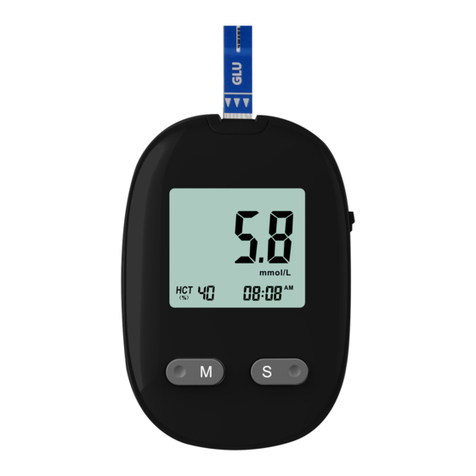
Sejoy
Sejoy BG-707 owner's booklet

Lifescan
Lifescan OneTouch Select Plus Simple owner's guide
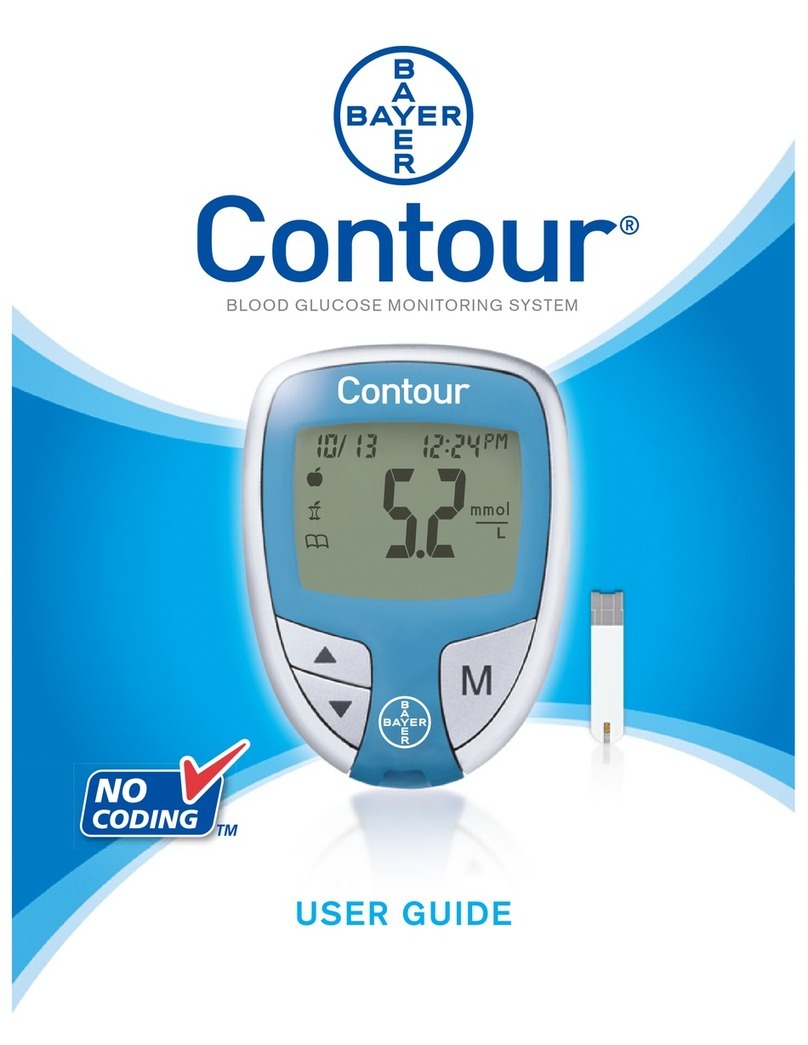
Bayer HealthCare
Bayer HealthCare BLOOD GLUCOSE MONITORING SYSTEM user guide
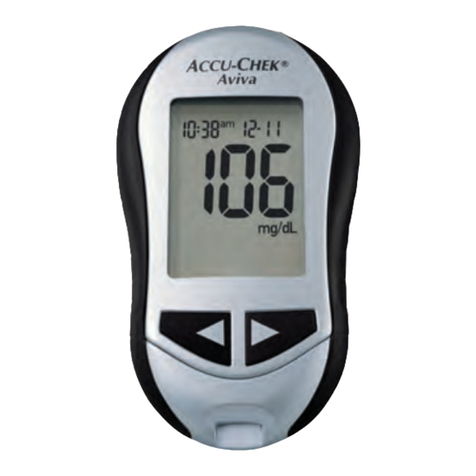
Accu-Chek
Accu-Chek Aviva owner's booklet

BERLIN-CHEMIE
BERLIN-CHEMIE MENARINI GlucoMen areo quick start guide
